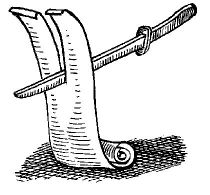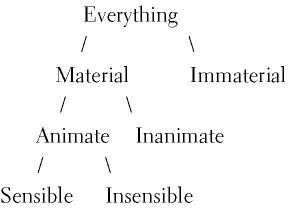The Book of Lost Books (25 page)


Ihara Saikaku
{1642â1693}
APART FROM MURASAKI SHIKIBU'S
The Tale of Genji,
the most widely admired and painstakingly reproduced novels in classical Japanese are those of Ihara Saikaku. With works such as
The Life of an
Amorous Man, Five Women Who Loved Love,
and
The Eternal Storehouse of Japan, or The Millionaire's Gospel, Revised Version,
he revolutionized the form, breaking with tradition in a wholehearted embrace of modernity. Although he tried his hand at writing samurai classics, it was the depiction of the
ch nin
nin
classâthe merchantsâthat typified his work. During the Tokugawa shogunate under which he was writing, the government's strongly isolationist policy and ruthless enforcement ensured the longest period of uninterrupted peace in Japan's history. It also encouraged the movement away from feudalism toward a more commercial society. Divorced from contact with other cultures, the old Buddhist ideal of the
ukiyo,
or “sad world,” was metamorphosing into its homophone, the more distinctively Japanese vision of “the floating world” of erotic abandon, eased by riches.
Saikaku did not purvey stale melancholy and world-weary acquiescence, but a vivid bustle of getting, losing, cheating, pleasing, and changing. Bordering on the pornographic, replete with humor, cynicism, charm, and ribaldry, he had, as the saying went, “not one Chinese character in his stomach.” Widowed at thirty-four, he launched himself into society with vigor, and not without causing some offense. A notable criticism of his work was entitled
Saikaku in Hell.
Before his career as a novelist, Saikaku was renowned as a poet. He, and the Danrin School, opposed the preeminent haiku writer of the day, Matsunaga Teitoku. Teitoku, influenced by Chinese aesthetics, emphasized concentration, the honing and whittling of seventeen syllables into their most perfect balance. Saikaku, on the other hand, wanted spontaneity, brilliance, and improvisation. His formidable skill can be seen in the accounts of
yakazu,
or poetry marathons, in which he competed.
In 1671, he astonished his contemporaries by extemporaneously composing 1,600 haiku in “a day and a night.” Nine years later, he notched up the almost fantastic rate of 4,000 in twenty-four hours. It was, however, in 1684 that he set his record: a phenomenal 23,500 haiku in the lifespan of a mayflyâslightly less than seventeen sets of seventeen syllables per minute. It is no wonder he was nicknamed “the 20,000 Poet.” Ephemerality was the quintessence of his genius: it is equally unsurprising that not all his work survived. He would not, one imagines, even have wanted it to.
Saikaku's method did have its detractors. His younger rival Bash , who became the most popular and renowned haiku writer, developed his own distinctive style of epiphanic compactness only after declaring himself dissatisfied with both Teitoku and the Danrin School. Others, disconcerted by the frequent oddness and impenetrability of Saikaku's off-the-cuff cadenzas, referred to him with an epithet that was synonymous with everything extravagant, far-flung, and downright peculiar: Saikaku, they declared, must be Dutch.
, who became the most popular and renowned haiku writer, developed his own distinctive style of epiphanic compactness only after declaring himself dissatisfied with both Teitoku and the Danrin School. Others, disconcerted by the frequent oddness and impenetrability of Saikaku's off-the-cuff cadenzas, referred to him with an epithet that was synonymous with everything extravagant, far-flung, and downright peculiar: Saikaku, they declared, must be Dutch.

Gottfried Wilhelm von Leibniz
{1646â1716}
OF ALL THE infinite, hypothetical Gottfried Wilhelm von Leibnizes, God chose to actualize the one that was born in Leipzig, on Sunday, July 1, 1646, to the professor of moral philosophy at Leipzig University and his third wife. This was the Leibniz who, since this is the best of all possible worlds, would develop differential calculus independently of Sir Isaac Newton, write the equation for a cycloid in parametric form (which, although he did not realize it, governs the destruction of matter in a black hole), and advance the System of Pre-established Harmony and the Principle of the Identity of Indiscernibles. He would, moreover, be paid for most of his life to write a book which he would never quite get around to, while researching a book that could never logically be written at all.
Though Leibniz has often been described as an Enlightenment thinker, or at least a precursor to the rationalist eighteenth century, his diversity of interests and lifelong concern with synthesizing those interests seem more akin to the role of the Renaissance man. Leibniz was, in short, a polymath of prodigious proportions. In addition to mathematics, theology, philosophy, and physics, he wrote on Chinese religion and the
I Ching,
silk production, fountain design, public health reforms, phantom-limb sensations, and inefficient heat loss in chimneys. He was also an alchemist and librarian, who spent years trying to drain the mines at Harz, and undertook the kind of diplomacy that edged into espionage.
In 1668, during the Polish succession crisis, he used a geometric proof to promote the claims of the candidate favored by the House of Brunswick, his employers. To strengthen the claim, he had it printed under the pseudonym of Georgius Ulicovius Lithuanus, with a fake title page asserting it was produced in Vilnius in 1659, adding the mystery of prophecy to the indisputability of mathematics.
After a spell in the service of Baron von Boineburg, Leibniz became court councillor to Duke Johann Friedrich of Hanover in 1676 (although it took a full year and several stern injunctions before he physically presented himself at court). He would remain with the family until his death, fulfilling a similar position for Duke Ernst August and George Ludwig (later George I), as well as being an intimate correspondent with the Electress Sophia and Queen Sophie Charlotte of Prussia.
In 1685, Duke Ernst August suggested that, in addition to Leibniz's supervision of the library and various political duties, he might write a history of the House of Brunswick, partially to codify their dynastic claims and partially, one suspects, out of vanity. The Brunswicks could trace themselves back to a semimythical family called the Guelfs: the d'Estes, another branch, claimed to be able to go back as far as their Roman ancestors. The courts of Hanover, Brunswick-Wolfenbüttel, and Celle were all contributing to the project and making available their archives. Ernst August's commission seemed clear: an account of their family from the earliest times.
Had the duke been more fully apprised of Leibniz's mathematical interests, especially the differential calculus that provided the limit of an infinite series, he might have substituted “since 825 C.E.” or “since the birth of Christ” rather than “from the earliest times.” Between 1698 and 1711, Leibniz published nine volumes of edited archival papers as a framework and reference source for the
History of the Brunswicks.
He drafted a preliminary essay for the book, the
Protogaea,
about geology and fossil formation, and a second work on the movement of early European tribes as inferred from the etymology of place names (during the course of which, incidentally, he proved conclusively that Swedish was not the oldest known language). One can understand the frustration of the various dukes, whose thirty-year investment looked increasingly unlikely to produce a neat précis of their grandparents' achievements.
A mild air of fiasco, or a charming whiff of foible, surrounds the
Historyof the Brunswicks
in its display of Leibniz's characteristic drive toward completeness. The same could be said about his proposed work on religion. His
Discourse on Metaphysics
was to be the first part of a massive disquisition that would encompass (after the proof of the existence of God through natural religion) a volume on revealed religion and a volume that explained and delimited the relative authorities of church and state. Leibniz's estimation of the effect of the treatise was as ambitious, and as hopelessly optimistic, as the work itself: it would reconcile the Roman Catholic and Lutheran churches. He even, through his notion of a “substantial connector,” claimed to be able to find common ground between Catholics, Lutherans, and Calvinists on the question of transubstantiation.
The
Demonstrationes Catholicae
never came about. Leibniz's major lost work, however, was not misplaced, or destroyed, or even really conceived: it was impossible. His schemes for integrating all the fields of knowledge, “harmonizing the philosophers” as he put it, crystallized into the idea of the
Universal Encyclopedia.
If we are to believe his own version of the facts, the idea first wormed into his brain at the age of thirteen. Having read all the poetry, history, and rhetoric in his father's library, he started on philosophy, and specifically Aristotelian logical syllogisms: “All men are mortal, Socrates is a man, therefore Socrates is mortal.” In its capacity to provide definitions, and to verify or falsify propositions, the syllogism seemed to him to be “the official roll call of all the things in the world.”
Complex ideas, he concluded, were made up of combinations of simpler ideas, just as words were made up of letters. Using the medieval technique of division, whereby a characteristic was identified as something certain objects possessed and others did not, concepts could be taxonomized: “everything” was made up of the “material” and the “immaterial,” the “material” could be divided into the “animate” and the “inanimate,” the “animate” into the “sensible”âor animalsâand “insensible”âplants and so forth.

Leibniz argued that the definition of the “species” always contained the “genus”: for example, the definition of “gold” included that of its genus, “metal.” By replacing a term with its definition, propositions could be tested; for example:
All gold is metal.
Replace gold with its definition:
All “yellow metal” is metal.
Since the same term appears on both sides, it is taken to be proven. This method of ratiocination was described by Leibniz as “an alphabet of human thought.”
This method had captured Leibniz's interest earlier in his life. His doctoral mathematical thesis,
De Arte Combinatoria,
had been a (not wholly successful) attempt to apply mathematical exactitude to the 256 “moods” of logical syllogisms. At stake was the possibility of a purely mechanical form of reasoning. Leibniz believed it was fundamentally possible to create a machine that, with the correct input, could imitate human reason.
Such projects were satirized by Jonathan Swift in
Gulliver's Travels.
On the island of Balnibarbi, Lemuel Gulliver encounters the Professors of the Academy, one of whom has a similar machine.
He then led me to the frame, about the sides whereof all his pupils stood in ranks. It was twenty foot square, placed in the middle of the room. The superficies were composed of several bits of wood, about the bigness of a die, but some larger than others. They were all linked together by slender wires. These bits of wood were covered on every square with papers pasted on them, and on the papers were written all the words of their language in their several moods, tenses and declensions, but without any order. The professor then desired me to observe, for he was going to set his engine at work. The pupils at his command took each of them hold of an iron handle, whereof there were forty fixed round the edges of the frame, and giving them a sudden turn, the whole disposition of the words had entirely changed. He then commanded six and thirty of the lads to read the several lines softly as they appeared upon the frame; and where they found three or four words together that might make a sentence, they dictated to the four remaining boys who were scribes . . . Six hours a day the young students were employed in this labour, and the professor showed me several volumes in large folio already collected, of broken sentences, which he intended to piece together, and out of those rich materials to give the world a complete body of all arts and sciences. . . .
Leibniz had already realized that the fundamental utility of any such machine was only as good as the quality of the data used in it. What was needed was a volume that contained accurate definitions of all possible axioms and individuals, with which the computer could set its dials. What differentiated each individual from every other individual, and their relative places within their genus, was the substance of the
Universal Encyclopedia.
Leibniz's various attempts to systematize human knowledge were never met with anything other than confused boredom or irascible impatience: they paid “no more attention than if I had related a dream,” carped Leibniz to the duc d'Orléans. He was even expressly forbidden to rearrange the library according to his principles. In Leibniz's correspondence, he resorts to specifying a book he needs by its position in the library relative to the window, or door, or its size, or color. His attempts to found and sustain academies, the published proceedings of which would contribute to the encyclopedia, were hampered and disappointed.
But he persisted. As early as 1676, stranded at Sheerness awaiting a boat back to the Continent, he had considered (since he could not understand the sailors) that the
Universal Encyclopedia
required a universal language. Chinese ideograms interested him, in their capacity to include in the word itself a sense of its definition. He also considered binary numbers, which he had invented previously. In a moment of hubris he had even grandiloquently imagined a medal in his honor being made proclaiming: “The Model of Creation discovered by G.W.L.: One is Enough to derive Everything from Nothing.”
There is an irony here, in that Leibniz's conception that the universal language had to be digital makes him seem shockingly modern: machines, logic, the primacy of binaryâall he needed was an inkling of electricity to imagine the possibility of a computer. Leibniz's vision of the
Universal Encyclopedia
relies on his microcosmic understanding of knowledge itself, where each part contains the whole. “In the least of substances, eyes as piercing as those of God could read the whole course of things in the Universe,” he wrote. This is where the
Universal
Encyclopedia
implodes.
Imagine all the atoms in the universe. To record the current position of each of them, let alone their past or future, requires an equal number of entities that can signify that position. If any particular atom is recording the position of another, where is its own position recorded? The total amount of information about the universe is greater than the total number of entities in it. A
Universal Encyclopedia
can never be written because there is not enough matter on which it could be transcribed.
Most of Leibniz's ideas are known to us, not through his published works, but through correspondence with other thinkers, memos to the dukes, and a mass of unedited notes. “He knows me not who knows me only through my publications” was one of his aphorisms. He is known now, mostly, because of one particular published work,
Theodicy,
and a satirist's indignation at its explanation of the existence of evil in a perfect universe.
Voltaire thought that Leibniz's formulationâthat everything is ordained for the best, and that our perception of things as “evil” or even “unfortunate” is merely an indication of our limitationsâwas ludicrous. As the ever-optimistic Dr. Pangloss in
Candide,
Voltaire immortalized an aspect of Leibniz. Yet the caricature contains a grain of truth.
